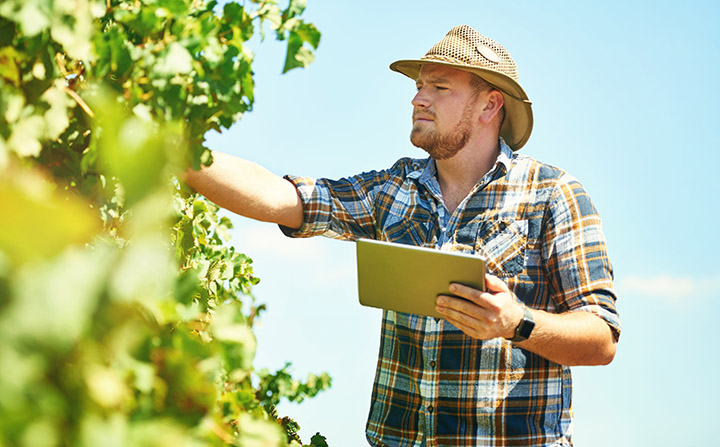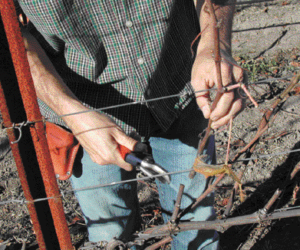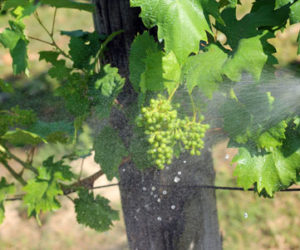With another vintage in the books, it would be easy to open a few bottles, kick our feet up, and relax after a lot of planning, execution, and the onset of fermentation. It’s a good idea, and I think you should. Taking a moment to let the year settle in and define itself is important, gives us perspective, and the taste of delicious homemade wine reminds us that all the blood, sweat, and tears were worth it.
But success requires agency, and the wine-farming plan should be tweaked every year to refocus on areas that require improvement. The goal is great wine — and we all know it’s easier to make it (or let nature make it) than grow it.

Through this column, we’ll break down our “Vineyard Postmortem” into a number of categories for discussion:
• Start a Vineyard Journal
• Post-Harvest Cleanup and Inspection
• Nutrient Considerations/Vine Health and Vigor
• Make a Plan for Pruning and Next Year’s Cultural Practices
Start a Vineyard Journal
In speaking to many of you through my consulting practice, at WineMaker conferences, and during online educational events through WineMaker, I know that many of you keep excellent records in the vineyard. I always recommend Dr. Richard Smart’s Sunlight Into Wine — a book that informs my vineyard philosophies and writing more than any other. It is highly recommended that you purchase this book, imbibe it like fine wine, and follow its directions while taking notes on the impact on the vineyard, and eventually the wine. My first rule of vineyard management: If it doesn’t increase the health of the vineyard AND the quality of the wine, it’s not worth your effort!
When it comes to keeping vineyard records, some prefer a different journal (a high school composition book is my choice) for each year’s farming and writing. A binder or even digital journal is fine too — whatever you can use that you will remember to keep copious notes in works.
So what should be in your journal?
Note timing, goals, and hours required for pruning, suckering, shoot positioning, leaf thinning, crop adjustment, and harvest.
Keep a chart of spray dates, materials, mix concentrations, any issues with equipment, penetration, etc.
Keep a record of watering: Blocks, hours, and how weather impacted irrigation sets.
Set sticky traps and log the insect pests you see in the vineyard and their general populations (Increasing? Decreasing?).
Note vertebrate pests and their impact: Squirrels, deer, pigs, birds, etc.
Keep a record of vigor — average shoot length in the vineyard, and record areas or vines that are lagging behind, or show extra vigor. Note spot fertilization of struggling vines and whether it impacts the vines catching back up.
Dates of important milestones: Budbreak, 6-, 12-, 24-inches (15-, 30-, 60-cm) of shoot growth (average), full canopy, flowering, fruit set, bunch closure, veraison onset and completion, harvest.
Detail your fruit testing after veraison. Keep track of Brix and pH, and you may want to correlate with heat and other weather conditions.
Make a record of fruit quality at harvest, recording issues like sunburn or mildew.
Finish the vintage with a short narrative of successes, failures, and improvements of timing, assessment, cultural practices to tweak for the next vintage. This is important to record while the year is still fresh in your mind.
Post-Harvest Cleanup and Inspection
I have seen commercial vineyards that are left without inspection after harvest. Nets are on the ground, buckets are strewn where they were abandoned, harvest snips are left on endposts. This shows a lack of discipline and also a wasteful attitude that will cause further purchases and costs if equipment is not gathered and maintained.
Inspection and cleanup can be done in a single pass through the vineyard. Here’s what to do:
Walk every row with your journal and pen in a backpack.
Gather all buckets/equipment and put them where they belong. Oil and sharpen clippers, wash buckets so they don’t stay sticky and dirty.
Shake the nets clean of leaves and debris and roll them into tidy bundles or leave them organized below the fruit zone on the trellis.
Put all of the materials, nets, etc. at the end of the rows on the same side and record any information about those rows. Was there fruit left on the vine? Vigor at the end of the season? Are some vines going into dormancy faster than others? Dead vines or areas that aren’t fruitful? Discolored or diseased leaves?
When managing a 28-acre vineyard, I would use different colored vinyl tape to attach to the trunks of vines that needed to be replaced, cordon arms to be replaced, vines showing disease/early leaf changes or dying back, vines that had fruit issues or no fruit, changes in vigor, etc. This is helpful once the vines are dormant and you can’t see these issues. Make sure to note in your journal what the different colors stand for. You can also write on the tape with a Sharpie, but that will fade over time.
Do a dead vine count and order vines for replacement. I recommend ordering 10% extra and start a little nursery outside the vineyard.
Fill in holes from ground pests like gophers or squirrels, and consider planting a cover crop. Raking/discing the cover crop seeds into freshly cultivated soil will keep the birds from eating all the seeds and likely give you a better cover crop once the first rains fall.
Take notes on areas of the vineyard that may need some trellis work: Tightening wires, adding more wires, replacing end posts or vine stakes.

Nutrient Considerations/Vine Health and Vigor
For this subject, you will need some data from the growing season, and as this is a growing-season issue, we’ll keep it short and simple.
When your vineyard begins to flower (late spring), take a “petiole sample,” putting a number of leaf blades in one paper sack and the leaf stems (petioles) in another, according to the lab sampling protocol, and send them into an agriculture lab for analysis. This gives you a baseline of nutrient status in your vineyard at the moment of the vine’s greatest nutrient requirement.
Using the petiole sample results, consider a fertilization plan for next spring, early in the season, starting at about 6–12 inches (15–30 cm) of average shoot growth.
If the nitrogen is deficient at the time of testing, and before bunch closure, you can add some, but I don’t recommend nitrogen additions afterwards.
Other nutrients can be added later, but I would recommend supplemental nutrition for the vineyard earlier in the season when possible.
Vine vigor should be measured in leaves per cluster per shoot, and I like 12–15 leaves per cluster across all varieties, 12 for small clusters (Pinot family, Chardonnay) and 15 for large clustered varieties like Grenache, Cabernet Sauvignon, etc.
If you have two clusters on shoots with less than 20 leaves, remove the top-most cluster before veraison.
When deciding how to tweak your canopy management for next year, look at your leaf-to-cluster ratio, then assess the quality and concentration of your wine from last year. If the wine is to your liking, you might not need to change anything.
If you want to increase vigor next year, leave less dormant buds/spurs/canes when you prune.
Measure your fruit yield/vine and put it in a ratio of the weight of the canes at pruning for the same vintage. This is called the “Ravaz Index.” The perfect ratio, according to my guru Dr. Richard Smart, is from 5:1 to 10:1.
Vine vigor should never exceed a height greater than your row spacing. So if your rows are eight feet (2.4 m) apart, the canopy should never exceed eight feet (2.4 m) in height, measured from the ground. A 1:1 ratio of row spacing to canopy height is necessary for sun to fully impact the vine and the fruit zone.
A vineyard with good leaf size, color, cane growth, cluster health and yield never needs supplemental fertilization. If it ain’t broke, don’t try to fix it!
Check your irrigation system for leaks, missing drippers, and test to make sure you are getting the same amount of water per hour at the top and bottom of the vineyard by putting a bucket under a few emitters, running the water for an hour and checking volume.
Make a Plan for Pruning and Next Year’s Cultural Practices
In a perfect world, you would have an entire year’s notes in your vineyard journal, and I would suggest reading the vintage’s story completely and taking a few more notes on elements of this year’s farming that could be improved. Looking at areas for improvement, do your research on what impacts these elements (pruning, canopy management, spray efficacy/mildew/rot pressure), and make a detailed plan on timing and scheduling the work.
For pruning: How is your system (cane, spur, goblet/head pruned, etc.) improving your wine? If cane pruning is too complicated, set up a cordon-trained, spur system. Vines are amazingly adaptable to new systems without the need for replanting.
For lower vigor vineyards, consider leaving smaller spurs to allow the vine’s energy to express itself through fewer routes.
For higher vigor vineyards, consider retrofitting your trellis into a system that allows for retention of more buds at pruning, like a quadrilateral, lyre, or other split-canopy system. If you have a powerful engine, give your vines a bigger road to use that muscle!
The biggest problem I see in small-scale and home vineyards is mildew and rot. If fungal diseases are a problem, increase your spraying interval (from 10 days to 7, for example). Never spray a higher concentration than suggested on the fungicide label, and measure VERY precisely. Buy a larger spray rig with better pressure, and always spray on both sides of the canopy and make sure the fruit zone is well saturated.
Finally, to follow is a list of cultural practices in approximate order of completion. Consider all of these in your plan for next year, and happy farming. If you get frustrated, take a break, pop a bottle from last year, or taste it as it ages, and allow the wine and the wine’s quality and faults to guide your future farming.
Winter (Dormancy):
Pruning: This involves removing unwanted or overgrown parts of the vine during its dormant period to control growth, optimize fruit production for the upcoming season, and shape the vine’s structure.
Vineyard maintenance:Inspecting and repairing trellises, irrigation systems, and general equipment to prepare for the growing season.
Soil management (pre-planting): If establishing a new vineyard, this involves site selection, preparing the ground, and installing irrigation systems. This might also include activities like planting cover crops for erosion control and adding nutrients to the soil
Spring (Budbreak and Growth):
Budbreak and shoot thinning: Monitoring the emergence of buds and new shoots, and remove excess shoots to ensure proper spacing, sunlight exposure, and airflow.
Vineyard floor management: Managing cover crops, including mowing and potentially incorporating them into the soil. Bare vineyard soil is the best practice for areas with spring frosts.
Pest and disease management: Monitoring for insect pests visually and with sticky traps. Gopher and squirrel control. Consider a jeweler’s loupe for looking at leaves early for signs of mildew spores. Once you can see mildew or rot with the naked eye, it’s basically too late for complete control.
Summer (Flowering, Fruit Set, and Ripening):
Canopy management: Adjusting leaves and shoots (e.g., leafing, scooping interior leaves, shoot positioning) to manage sunlight exposure and airflow. This is crucial for grape ripening and disease prevention. Be careful not to pull too many leaves in areas of heat/excessive sun.
Green pruning/cluster thinning: Removing unripe or excess grape clusters to concentrate the vine’s energy on the remaining fruit, thus improving quality. I like to remove all clusters that haven’t finished veraison when 95% of the vineyard has softened/colored.
Irrigation (if needed): Providing water, especially in drier climates, to ensure vine health and fruit development. Sandy soils need more irrigation, clay soils need less. Annual rainfall above 20–25 inches (50–64 cm) may allow for dry farming (no irrigation), which saves a lot of costs in installation. Having an irrigation system gives us a lot of control, though.
Fall (Harvest and Post-Harvest):
Harvest: Picking the grapes when they reach optimal ripeness, based on factors like sugar content, pH, seed color (brown at least 75% and crunchy), acidity, and flavor.
Post-Harvest: After the grapes are picked, dump tons of water on each vine (10–20 gallons/40–75 L) to help the vines flush their roots if the soil is still dry at harvest.
Before next year: Maintain, clean, and store all farming equipment and implements, consider improvements and upgrades for next year.






